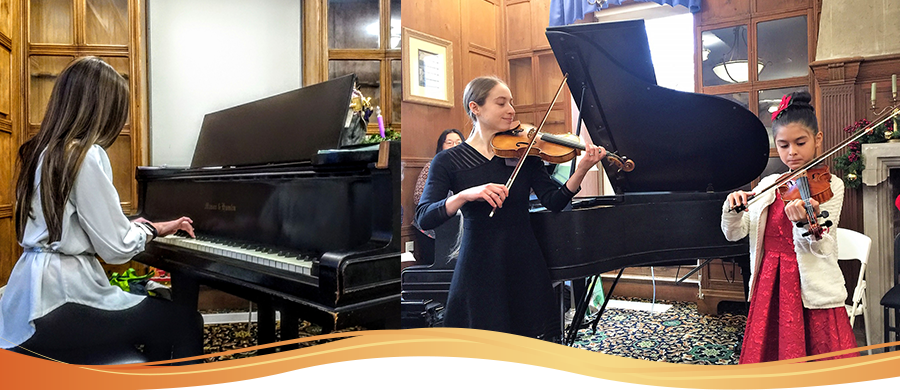
Online
Music for the Community
If you're interested in a particular category, you can sort performances by student age, instrument, singalong music, composer and so on - click on the orange tags under the text. We hope you and your family will enjoy watching our students share their music!
To have each week's videos and accompanying info sent to your inbox*, please subscribe via the orange button.
*Videos are delivered twice weekly; you can unsubscribe at any time, and we will never share or sell your info.
Subscribe to this Page
Displaying items by tag: Students age 15 to 18
Day 58 - Arpeggione Sonata by Schubert
Violist age 18 plays Arpeggione Sonata by Schubert
Franz Schubert (1797 – 1828) wrote this sonata in November 1824, for an instrument that had been invented only the previous year! It’s the only major composition for the arpeggione - basically a bowed guitar – that is still played today, albeit by other instruments.
The sonata was probably commissioned by Schubert's friend Vincenz Schuster, who was already a virtuoso of the arpeggione, even so soon after its invention. But unfortunately it wasn’t published till 1871, long after Schubert’s death – by which time the excitement about this new instrument had long since disappeared, along with the arpeggione itself.
Schubert’s beautiful composition lives on, though, and today it's usually performed by viola or cello. There are versions for other instruments, too — including double bass, flute, euphonium and clarinet for the arpeggione part, or with guitar or harp for the piano part. And now in the 21st century, interest in the aprpeggione has revived, with several composers writing for it - so perhaps we'll be able to hear it again as Schubert intended in the not too distant future.
For more music by Schubert, see here.
Day 55 - Bach Concerto for Two Violins
Violinists age 12 and 16 play Bach Concerto in D minor for Two Violins, second movement
The beloved "Bach Double", one of the composer's most famous works, is usually recognized by its fast first movement. Here, though, we're featuring the lyrical second movement with its expansive, lilting melody. The two violinists have equal parts that weave in and out of each other in a soulful musical conversation in the flowery Baroque style, taking turns with the melody and the accompaniment, finally coming to rest together.
Bach probably wrote this concerto when he was "Kapellmeister" - Director of Music - at the court Prince Leopold of Anhalt-Cothen between 1717 and 1723. This was a very happy employment situation for Bach - Prince Leopold, who was a musician himself, appreciated Bach's talents, paid him well, and gave him a lot of freedom to compose and perform whatever suited him. Much of the music of Bach that we've shown in this series comes from this time, including the orchestral suites and cello suites, as well as his music based on 18th century dances (here, here, and here).
Day 49 - Bach Prelude from Suite in G
Violist age 14 and Cellist age 16 play Bach Prelude in G major
Because of their musical and technical difficulty, the Suites were not much performed until the great 20th century cellist Pablo Casals took them up, after discovering them in a thrift shop in Barcelona, Spain at the age of 13. His famous recordings of them were selected in 2019 for preservation in the Library of Congress.
Day 38: Bourrée 1 & 2 by Bach
Cellist age 16 plays Bourrées I & II from Bach Solo Suite #3 in C
More old-fashioned dance music today, but unlike a Minuet, a Bourrée (pronounced "boo-ray") is in duple time (ONE two, ONE two) – similar to a Gavotte. Still, like our Minuet and Trio on Day 36, this set of two Bourrées is again made on an overall A B A pattern.
Day 35: Vivaldi Cello Sonata in A minor
Cellist age 15 plays Vivaldi Cello Sonata in A minor
Born in Venice on the day of an earthquake, Italian composer Antonio Vivaldi (1678 -1741) is regarded as one of the greatest composers of the Baroque era, and during his lifetime he was famous across Europe. He composed many instrumental works, especially for string instruments - many of which were written for girls at the orphanage in Venice, whose musical skill improved their marriage prospects at a time when there were few other options for women. He also wrote a large amount of church music, and more than forty operas. His best-known work is the series of violin concertos known as the Four Seasons - we featured "Spring" earlier in this series.
Vivaldi wrote a set of six cello sonatas (works for a solo instrument, usually with accompaniment by a keyboard) between 1720 and 1730. All of them have four alternating slow and fast movements (separate pieces); this is the second movement of the third sonata.
Day 30: Mozart Violin Concerto #3 (Skills, part 5)
Violinist age 16 plays Mozart's Violin Concerto #3 in G major, 1st movement
Day 29: Seitz Viola Concerto in D (Skills, part 4)
Violist age 15 plays Seitz Concerto in D, first movement
Day 21: Allegro Appassionato by Saint-Saens
Cellist age 16 plays Allegro Appassionato by Saint-Saens
French composer Camille Saint-Saens (pronounced Sanh-Sonh) was born in Paris in 1835. By the time he was three he was picking out tunes on the piano, and his great-aunt started teaching him. He made his professional debut at the age of 10, and also became a brilliant organist.
His first job was as a church organist, which allowed him time to pursue his interests in piano and composing. He later became a beloved teacher at a school for future organists and choirmasters, and wrote his famous “Carnival of the Animals” with his students in mind (although he didn’t finish it till much later, after he left the school).
Day 15: Haydn Cello Concerto in C
Cellist age 15 plays Haydn Cello Concerto in C, first movement
Day 9: Courante, Bach Suite #3 in C
Violist age 16 plays “Courante” from Bach Suite #3 for Viola/Cello
A viola is more than just a “big violin”. That extra size gives it a deeper, darker sound. Bigger things vibrate more slowly - try filling a smaller glass and a bigger glass with water, and tapping them each with a fork, and you’ll hear that idea at its most basic.
The viola has the same tuning as the cello, except an octave higher (meaning the viola’s strings vibrate exactly twice as fast as a cello’s) - so they can share some of the same music, including Bach’s solo suites. “Suite” means a collection of pieces which go together, and Bach’s suites are collections of 18th century dance music. “Courante” literally means “running”, and you can hear how this piece just keeps going and going – try running around to it!
If you like the sound of the viola, it’s a great instrument to learn to play – there are never enough viola players, and you will get lots of invitations to play with others!


